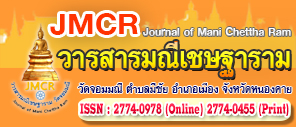ADVANTAGES AND VALUES OF BUDDHIST LITERATURE ENTITLED EMPEROR ASOKA OF VASIN INTHASARA: AN ANALYTICAL STUDY
Keywords:
Buddhist Literature, Emperor Asoka, Vasin InthasaraAbstract
This research article has the following objectives: 1) to study Buddhist literature, 2) to study Buddhist literature on the Asoka Emperor written by Vasin Inthasara, and 3) to analyze the benefits and value of the Asoka Emperor written by Vasin Inthasara. It is documentary qualitative research in which all data collected from the primary sources, Tipitaka and the Buddhist literature on the Asoka Emperor written by Vasin Inthasara and the other secondary sources, the commentaries, texts and related researches. The inductive and content analysis was analyzed in this thesis.
The research results found that
Buddhist literature is based on the teachings of the Buddha, collected, edited and transmitted by monks in oral and written forms. It is important in the context of Buddhist principles and guideline of practicing according to the Eightfold Path, which results in faith, virtue, and reflects the benefits on the historical and literature value. It also enables people to train themselves by abandoning harmful things and doing good deeds for attaining the highest happiness.
The Buddhist literature of Emperor Asoka is a literary work written by Archarn Wasin Inthasara. This work is a portrayal of the life history of Emperor Asoka through a novel-based writing based on moral principles, showing the royal conduct and glorifying Emperor Asoka, along with presenting Buddhist principles of love, giving alms, not harming, and governance.
Buddhist literature of Emperor Asoka has shown the 4 aspects of benefits and value: 1) The literary aspect showing 9 literacy emotions, especially the beneficial emotional aspect is the highlight; 2) The historical aspect emphasizing the royal duties of Emperor Asoka in each period, who is a good example of a Buddhist; 3) The propagation aspect showing the system and method of propagation of Buddhism by Emperor Asoka that resulted in faith in a wide area; 4) The moral aspect showing a picture of the reality of life in a tangible way that one must conduct oneself with heedfulness and accumulating only good deeds.
References
จี. ศรีนิวาสัน. (2545). สุนทรียศาสตร์. (สุเชาว์ พลอยชุม, แปล). (พิมพ์ครั้งที่ 2). กรุงเทพมหานคร: มหาวิทยาลัยมหามกุฏราชวิทยาลัย.
ที.ดับบลิว. ริส เดวิดส์. (2562). พระพุทธศาสนาในชมพูทวีป. (สมัย สิงหศิริ, แปล). (พิมพ์ครั้งที่ 2). กรุงเทพมหานคร: มหามกุฏราชวิทยาลัย.
ปีเตอร์ ฟรานโคพาน. (2563). เส้นทางสายไหม. (คุณากร วาณิชย์วิรุฬห์, แปล). กรุงเทพมหานคร: บุ๊คสแคป.
พระณัฐวุฒิ มหาวิริโย (ก้อนจา). (2563). ศึกษาเชิงวิเคราะห์หลักพุทธธรรมที่ปรากฏในธรรมนิยายเรื่องลีลาวดี. วิทยานิพนธ์ปริญญาศาสนศาสตรมหาบัณฑิต, สาขาวิชาพุทธศาสนาและปรัชญา, บัณฑิตวิทยาลัย, มหาวิทยาลัยมหามกุฏราชวิทยาลัย.
พระพุทธโฆสเถระ. (2563). ปฐมสมันตปาสาทิกาแปล เล่ม 1. (กองตำรามหามกุฏราชวิทยาลัย, แปล). (พิมพ์ครั้งที่ 13). กรุงเทพมหานคร: มหามกุฏราชวิทยาลัย.
พระมหานามเถระ และคณะบัณฑิต. (2553). คัมภีร์มหาวงศ์ ภาค 1. (สุเทพ พรมเลิศ, แปล). พระนครศรีอยุธยา: มหาจุฬาลงกรณราชวิทยาลัย.
พระอธิการกฤษดา สุทฺธิญาโณ (เรืองศิลป์). (2561). ศึกษาอิทธิพลของปัญญาสชาดกที่มีต่อสังคมไทย. วิทยานิพนธ์ปริญญาพุทธศาสตรมหาบัณฑิต, สาขาวิชาพระพุทธศาสนา, บัณฑิตวิทยาลัย, มหาวิทยาลัยมหาจุฬาลงกรณราชวิทยาลัย.
มหามกุฏราชวิทยาลัย. (2557). พระไตรปิฎกและอรรถกถาแปล ชุด 91 เล่ม ฉบับครบ 200 ปี แห่งราชวงศ์จักรี กรุงรัตนโกสินทร์ พุทธศักราช 2525. (พิมพ์ครั้งที่ 8). กรุงเทพมหานคร: มหามกุฏราชวิทยาลัย.
ยูจีน เบอร์นูฟ. (2566). พระเจ้าอโศก. (สุข พูลสุข, แปล). (พิมพ์ครั้งที่ 5). กรุงเทพมหานคร: มหามกุฏราชวิทยาลัย.
วศิน อินทสระ. (2544). จอมจักรพรรดิอโศกฉบับสมบูรณ์. (พิมพ์ครั้งที่ 5). กรุงเทพมหานคร: สร้างสรรค์บุ๊คส์.
วิจิตตรี ธรรมรักษ์. (2554). การศึกษาเชิงวิเคราะห์วรรณกรรมอิงหลักธรรมทางพระพุทธศาสนา เรื่องพระอานนท์พุทธอนุชา. วิทยานิพนธ์ปริญญาพุทธศาสตรมหาบัณฑิต, สาขาวิชาพระพุทธศาสนา, บัณฑิตวิทยาลัย, มหาวิทยาลัยมหาจุฬาลงกรณราชวิทยาลัย.
วิชัย กิตติยะอำพล. (2558). ศึกษาวิเคราะห์บทบาทของพระเจ้าอโศกมหาราชที่มีต่อพระพุทธศาสนาจากจารึกอโศก. วิทยานิพนธ์ปริญญาศาสนศาสตรมหาบัณฑิต, สาขาวิชาพุทธศาสน์ศึกษา, บัณฑิตวิทยาลัย, มหาวิทยาลัยมหามกุฎราชวิทยาลัย.
วิศิษย์ ปิ่นทองวิชัยกุล. (2548). เดอะ ไลท์ ออฟ เอเชีย ของเซอร์ เอ็ดวิน อาร์โนลด์: ภูมิปัญญาตะวันออกในโลกตะวันตก. วิทยานิพนธ์ปริญญาอักษรศาสตรมหาบัณฑิต, สาขาวิชาวรรณคดีเปรียบเทียบ, อักษรศาสตร์, จุฬาลงกรณ์มหาวิทยาลัย.
สมเด็จพระมหาสมณเจ้า กรมพระยาวชิรญาณวโรรส. (2557). พุทธประวัติ เล่ม 1. (พิมพ์ครั้งที่ 56). กรุงเทพมหานคร: มหามกุฏราชวิทยาลัย.
สุภาพรรณ ณ บางช้าง. (2526). ประวัติวรรณคดีบาลีในอินเดียลังกา. กรุงเทพมหานคร: จุฬาลงกรณ์มหาวิทยาลัย.
เสฐียรโกเศศ (พระยาอนุมานราชธน). (2533). การศึกษาวรรณคดีแง่วรรณศิลป์. (พิมพ์ครั้งที่ 4). กรุงเทพมหานคร: ราชบัณฑิตยสถาน.
เสถียร โพธินันทะ. (2543). ประวัติศาสตร์พระพุทธศาสนา. (พิมพ์ครั้งที่ 4). กรุงเทพมหานคร: มหามกุฏราชวิทยาลัย.
อาร์ บาซัค. (2540). จารึกอโศก. (พระธรรมปิฎก, แปล). (พิมพ์ครั้งที่ 4). กรุงเทพมหานคร: ธรรมสภา.
เอ.พี. เดอ ซอยสา. (2562). วัฒนธรรมอินเดียสมัยพุทธกาล. (ส.พ.ช. แปล). กรุงเทพมหานคร: มหามกุฏราชวิทยาลัย.
Alexander Cunningham. (1854). The Bhilsa Topes or Buddhist Monuments of Central India: Comprising a Brief Historical Sketch of the Rise, Progress and Decline of Buddhism. London: Smith, Elder.
E.W. Adikaram. (1953). Early History of Buddhism in Ceylon. (2nd Ed.). Columbo: M.D. Gunasena Co., Ltd.


